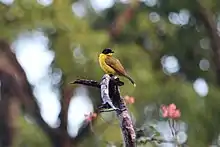Black-capped bulbul
The black-capped bulbul (Rubigula melanicterus), or black-headed yellow bulbul, is a member of the bulbul family of passerine birds.[1][2] It is endemic to Sri Lanka.[3]
| Black-capped bulbul | |
|---|---|
.jpg.webp) | |
| Scientific classification | |
| Kingdom: | Animalia |
| Phylum: | Chordata |
| Class: | Aves |
| Order: | Passeriformes |
| Family: | Pycnonotidae |
| Genus: | Rubigula |
| Species: | R. melanicterus |
| Binomial name | |
| Rubigula melanicterus (Gmelin, 1789) | |
| Synonyms | |
| |
Taxonomy and systematics
The black-capped bulbul was originally described in the genus Muscicapa and later moved to Pycnonotus.[4] Pycnonotus was found to be polyphyletic in recent molecular phylogenetic studies and five bulbul species, including the black-capped bulbul, moved to Rubigula.[2][5] Until 2008, the black-capped bulbul was considered as conspecific with the black-crested, ruby-throated, flame-throated and Bornean bulbuls. Some authorities have considered the ruby-throated, flame-throated and Bornean bulbuls to be subspecies of the black-capped bulbul[6]
Description

The black-capped bulbul is virtually crestless and has a yellow throat and brownish eyes. It is yellowish green above and yellow below. The tail is brownish and ends in a white tip. The male has red irides and female has brown irides. Calls include a broad repertoire of sweet, mellow, minor-key piping whistles and sharper calls. Breeding records are from March to September.
Distribution and habitat
This is a bird of forest and dense scrub. It builds its nest in a bush; two to four eggs is a typical clutch. The black-capped bulbul feeds on fruit and insects. Found in forests, wooded areas and in gardens. Usually found in pairs.
In culture
In Sri Lanka, this bird is known as Hisa kalu Kondaya - හිස කලු කොන්ඩයා in Sinhala language.
References
- BirdLife International. (2016). "Rubigula melanictera (formerly as: Pycnonotus melanicterus)". IUCN Red List of Threatened Species. 2016: e.T103825842A94339991. doi:10.2305/IUCN.UK.2016-3.RLTS.T103825842A94339991.en.
- Gill, F.; Donsker, D.; Rasmussen, P. (eds.). "Family Pycnonotidae". IOC World Bird List. Version 10.2. International Ornithological Congress. Retrieved 9 August 2020.
- Warakagoda, Deepal (April 2009). "The Avifauna of Sri Lanka: An Overview of Current Status". Taprobanica. 1 (1): 32. doi:10.4038/tapro.v1i1.2775. Retrieved 2 January 2019.
- "Pycnonotus melanicterus - Avibase". avibase.bsc-eoc.org. Retrieved 11 March 2017.
- Shakya, Subir B.; Sheldon, Frederick H. (2017). "The phylogeny of the world's bulbuls (Pycnonotidae) inferred using a supermatrix approach". Ibis. 159 (3): 498–509. doi:10.1111/ibi.12464. ISSN 0019-1019.
- "Species Version 1 « IOC World Bird List". www.worldbirdnames.org. Retrieved 11 March 2017.
- Rasmussen, P.C., and J.C. Anderton. 2005. Birds of South Asia. The Ripley guide. Volume 2: attributes and status. Smithsonian Institution and Lynx Edicions, Washington D.C. and Barcelona.
| Wikimedia Commons has media related to Pycnonotus melanicterus. |
